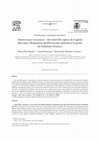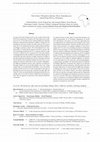Papers by pierre-elie moullé
HAL (Le Centre pour la Communication Scientifique Directe), 2011
Bulletin du Musée d' …, 2009
Résumé/Abstract Le Pléistocène inférieur est connu aux grottes de Grimaldi (ou Balzi Rossi, Vinti... more Résumé/Abstract Le Pléistocène inférieur est connu aux grottes de Grimaldi (ou Balzi Rossi, Vintimille, Italie) grâce à la Tour de Grimaldi (ou grotte Grimaldi) mais l'exposé de deux cas particuliers de fossiles datant de cette période et provenant de la grotte du Prince pose la ...

Bulletin Du Musee D Anthropologie Prehistorique De Monaco, 2005
Les grottes de la vallee de l'Erve, dans le departement de la Mayenne, sont connues pour leur... more Les grottes de la vallee de l'Erve, dans le departement de la Mayenne, sont connues pour leurs vestiges du Paleolithique moyen final et, surtout, du Paleolithique superieur. Les sondages realises en 1999 et 2000 devant la grotte de la Chevre avaient pour objectif de cerner l'extension des fouilles du XIX e siecle. Le remanie de ces fouilles a livre de nombreux objets du Paleolithique moyen final, du Paleolithique superieur et d'epoques plus recentes. Deux fossiles se distinguent cependant dans cette collection. Il s'agit d'un fragment de canine superieure d'Homotherium cf. latidens et d'une molaire superieure attribuee a cf. Dama clactoniana qui indiquent qu'un niveau plus ancien, pouvant dater du Pleistocene moyen, etait ou est encore present dans la grotte. La mise en evidence d'un tel niveau serait importante pour la connaissance de cette periode dans le Grand-Ouest de la France car le seul site remarquable du Pleistocene moyen actuellement connu dans cette region est celui de Menez-Dregan (Finistere) dans lequel la faune est tres mal conservee.
Bulletin Du Musee D Anthropologie Prehistorique De Monaco, 2006
Les dents deciduales de Pachycrocuta brevirostris Aymard, 1846 de la grotte du Vallonnet (Pleisto... more Les dents deciduales de Pachycrocuta brevirostris Aymard, 1846 de la grotte du Vallonnet (Pleistocene inferieur) et de Crocuta crocuta spelaea Goldfuss, 1777 de la grotte du Rey (Pleistocene superieur) sont comparees. La collection de la grotte du Rey comporte tous les types de dents deciduales jugales. La collection du Vallonnet est assez complete, mais ses d 3 sont fragmentees et la d 4 manque. L'etude de ces collections, avec la prise en compte de donnees de la bibliographie, amene a confirmer la proximite de la forme Crocuta et de la lignee Pliocrocuta-Pachycrocuta. A l'interieur de cette derniere, l'evolution de la denture va dans le sens d'une augmentation des capacites tranchantes comme cela est observe pour les dents definitives.
HAL (Le Centre pour la Communication Scientifique Directe), 2018
Bulletin du Musée d'anthropologie préhistorique de Monaco, 2012
HAL (Le Centre pour la Communication Scientifique Directe), 2011

Quaternary Science Reviews, 2021
Abstract The evolutionary history of Bison is a matter of debate due to the scarcity of fossil re... more Abstract The evolutionary history of Bison is a matter of debate due to the scarcity of fossil remains from the earliest members of this clade and the close morphological similarities among species. To clarify the taxonomic status of the earliest stouter bison and their relationships to their putative ancestor, Leptobos, as well as other primitive forms traditionally referred to subgenus Bison (Eobison), we carry out a complete revision of the available European fossil record, with a focus on the forms occurring during the Early-Middle Pleistocene Transition. Emphasis is put on the description of the unpublished Bison remains from the Vallparadis Composite Section (VCS), including the sites of Cal Guardiola and Vallparadis Estacio (Terrassa, NE Iberian Peninsula). VCS fossiliferous layers yielded one of the richest faunal assemblages from the European latest Early Pleistocene and one of the few European fossil sites covering almost entirely the Early-Middle Pleistocene Transition (1.2–0.6 Ma). The collection comprises thousands of ungulates remains, especially abundant fossils of a large Bison species. The morphology of the postcranial sample from VCS fits that of Bison (Bison) schoetensacki, i.e., the earliest stout bison (Bison s.s.) recorded in Europe. We studied more than 200 cranial and postcranial elements with a focus on the metapodial remains. Comparisons were performed with all the available fossil record of Pleistocene Eurasian fossil Bison species. We confirm the taxonomic validity of B. schoetensacki and recognize distinct eco-morphotypes of European bison between the late Early Pleistocene and the beginning of the Holocene based on the size and proportions of the metapodials. Although the appendicular skeleton shows reliable characters for the diagnosis of different species, the great morphological homogeneity recognized within the genus requires a cautious approach in systematic studies based on postcranial material.

Quaternary Science Reviews, 2020
The Vallparadís composite section (VCS) includes the nearby paleontological sites of Cal Guardiol... more The Vallparadís composite section (VCS) includes the nearby paleontological sites of Cal Guardiola and Vallparadís Estaci o (Vall es-Pened es Basin, northeastern Iberian Peninsula). The section spans from before the Jaramillo subchron to the early Middle Pleistocene (ca. 1.2e0.6 Ma). In this study, we describe the suid record from VCS and we review those from several other European sites, in order to refine the taxonomic identity and chronostratigraphic range of Quaternary suids in Europe. The VCS sample includes a nearly complete skull, several teeth, and postcranial elements, and stands out as the richest European suid collection from the latest Early Pleistocene. Suid remains have been unearthed from both Cal Guardiola and Vallparadís Estaci o layers, whose age spans from the Jaramillo subchron (ca. 1.07 e0.99 Ma; MIS31) to post-Jaramillo time (ca. 0.86 Ma; MIS21). Several craniomandibular and dental morphological features support an attribution to Sus strozzii. These features include a low and very deep preorbital fossa, a narrow nuchal crest, a well-developed longitudinal swelling in the middle of the mandibular corpus, the presence of styles/stylids in the upper/lower premolars, and especially the "verrucosic" morphology of the lower canine. The attribution to S. strozzii is also sustained by a cladistic analysis. These results provide interesting clues on the chronological occurrence of Quaternary suids. Sus strozzii is relatively common in Europe during the middle and early late Villafranchian (ca. 2.5e1.8 Ma), but it almost completely disappears during the latest Villafranchian (ca. 1.8e1.2 Ma). During and slightly after the Epivillafranchian (ca. 1.2e0.8 Ma), S. strozzii reappears in Europe although with relatively small samples, at VCS and several other sites including Untermassfeld (Germany; ca. 1.0 Ma), Le Vallonnet (France; ca. 1.2e1.1 Ma), Taman Peninsula (Russia; ca. 1.1e0.8 Ma), Arda River (Italy; ca. 0.99 Ma), and Slivia (Italy; ca. 0.8 Ma), among others. Consequently, in contrast to previous knowledge, we conclude that (1) S. strozzii survived in Europe (or returned there with a second dispersal event from Asia during the Epivillafranchian) at least until the end of the Early Pleistocene and (2) the arrival of Sus scrofa into that continent is not older than the Early-Middle Pleistocene boundary.

Paléo, Dec 15, 2012
Rochefort cave, in the village of Saint-Pierre-sur-Erve, is part of the group called "les grottes... more Rochefort cave, in the village of Saint-Pierre-sur-Erve, is part of the group called "les grottes de Saulges" (Saulges' caves), which are all found along a ca. 1.5 km stretchPaleoLab2013-06-18T14:22:00 of the Erve River (fig. 1). The cave, visited since Palaeolithic times, has long been known: it is presently one of two caves in the valley open for guided tours. It is one of the largest caves of the group with a total length of 250 m, divided into an upper and a lower karst. The upper level was the only one accessible in prehistoric times: it is made of a 24 m long access corridor that opens up into a large chamber. In spite of several excavations at the end of the 19 th century and in the 1930s that identified a Palaeolithic presence in the cave, the surfaces available for modern archaeological research remain significant. Since 2011, a multi-year excavation has been carried out in part of the large chamber which led to the identification of a remarkable Solutrean level (fig. 1). Indeed the Solutrean layer of Rochefort cave, with its lithic and faunal assemblages and the presence of art on plaquettes and bone has all the characteristics of a real habitation site (Hinguant and Colleter dir. 2010; Hinguant and Biard in press; Pigeaud in press). 2 For practical reasons, the excavated area presently covers only half of the chamber. The excavations clearly show that we are at the periphery of the occupation, in an area in which refuse seems important and where spatial organisation is hardly perceptible. Even so, refuse from a hearth and a structure constructed with limestone blocks, at the Middle Solutrean engraved bone artefacts from Rochefort Cave (Saint-Pierre-su...

Comptes Rendus Palevol, Dec 1, 2004
Reçu le 5 avril 2004 ; accepté après révision le 20 septembre 2004 Présenté par Henry de Lumley R... more Reçu le 5 avril 2004 ; accepté après révision le 20 septembre 2004 Présenté par Henry de Lumley Résumé Une nouvelle espèce d'Ammotragus est décrite à partir de fossiles provenant de l'ensemble III de la grotte du Vallonnet (Roquebrune-Cap-Martin, Alpes-Maritimes, France). Ces fossiles étaient auparavant attribués au genre Ovis, mais le ré-examen de la collection dentaire du gisement ainsi que la première étude d'un fragment crânien montrant les compartiments moyens droit et gauche des sinus frontaux caudaux, les pariétaux, les temporaux et le basisphénoïde, ont permis de mettre en évidence des différences anatomiques claires avec les genres de la tribu des Caprini : Ovis, Capra, Hemitragus, et de la tribu des Ovibovini : Soergelia. À l'opposé, des similitudes sont observées avec le genre Ammotragus, connu jusqu'alors seulement en Afrique du Nord. L'ensemble III du Vallonnet est contemporain de l'épisode paléomagnétique de Jaramillo et a un âge de 1 Ma. Des dents similaires à celles de l'Ammotragus du Vallonnet ont été découvertes dans le site de Fuente Nueva-3 (Orce, Andalousie, Espagne).

Journal of African Archaeology, Dec 1, 2011
Located in the Omo-Turkana basin at the northern limit of the Koobi Fora sedimentary Formation, t... more Located in the Omo-Turkana basin at the northern limit of the Koobi Fora sedimentary Formation, the Fejej region has recently proven to be a rich study area for understanding early hominin behaviour and paleoenvironmental conditions. Among the rich fossiliferous and stone artefact localities discovered so far at Fejej, the FJ-1a archeological site has yielded a faunal and lithic assemblage in primary context. The archeological level is situated within a 15 meter fluvial sequence beneath a volcanic tuff. Geochronological data from the FJ-1 sequence indicate an age of nearly 1,9 Ma for the FJ-1a artefact level. The stone industry was knapped from locally available raw materials (mainly quartz and basalt) and rocks had been carefully selected according to specific petrographical and formal criterion. Hominins mastered several distinct stone knapping methods and used more or less exhaustive reduction sequences in order to produce small flakes. The different techniques used for stone reduction are defined in this paper thanks to a series of refits of flakes onto cores. Along with the refits, an in-depth analysis of the flakes, cores and worked pebbles provides an overview of the technological capacities of hominins present at the site nearly 2 million years ago. After the Fejej FJ-1a site was abandoned the archeological materials were rapidly buried, leaving an almost undisturbed archeological level. This site appears to represent a short episode of hominin occupation.
L'Anthropologie, Dec 1, 2006
The large mammals of Vallonnet cave, found into a level contemporary of Jaramillo event, are char... more The large mammals of Vallonnet cave, found into a level contemporary of Jaramillo event, are characteristics of the second half of the Lower Pleistocene. Some differences with the faunas of Fuente Nueva 3 and Barranco Leon, in Spain, which datation is the middle of ...
HAL (Le Centre pour la Communication Scientifique Directe), 2020
National audienc
HAL (Le Centre pour la Communication Scientifique Directe), 2020
National audienc
... Les grands mammifères fossiles du Velay : les collections paléontologiques du Plio-Pléistocèn... more ... Les grands mammifères fossiles du Velay : les collections paléontologiques du Plio-Pléistocène du musée Crozatier, Le Puy-en-Velay, Frédéric Lacombat (Ed.) (2004) 105-124. Le début du Pléistocène moyen, le Galérien moyen. ...
Archéologie de la France-informations, Mar 1, 2007










Uploads
Papers by pierre-elie moullé